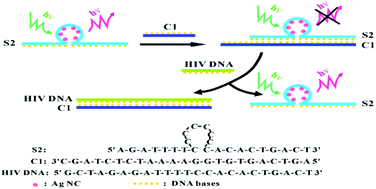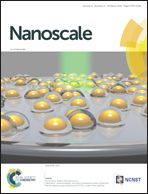HIV-related DNA detection through switching on hybridized quenched fluorescent DNA-Ag nanoclusters†
Abstract
In this paper, DNA containing six cytosines as the formation site for silver nanoclusters (Ag NCs) was adopted as a template for preparing fluorescent DNA-Ag NCs. For the first time, it was found that the fluorescence of DNA-Ag NCs could be quenched after hybridization with their complementary sequence. On the basis of this new phenomenon, we designed a sequence C1 that was completely complementary to human immunodeficiency virus (HIV) DNA, and probe DNA which was partially complementary to C1 for the synthesis of DNA-Ag NCs. The fluorescence of DNA-Ag NCs was quenched after hybridization with C1 and the DNA-Ag NCs/C1 composite was formed, while C1 could be dissociated away from the DNA-Ag NCs by HIV DNA through a strand exchange reaction due to the stronger affinity between HIV DNA and C1, which could switch on the quenched Ag NCs, thus a new “off–on” fluorescence method for HIV DNA detection was developed. In the experiment, the Ag NCs formation site of DNA, the number of base pairs, and the pH and salt concentration of binding buffer were optimized. Under the optimum conditions, the limit of detection for HIV DNA was obtained to be 3.18 nM (3σ/N, n = 7) with the linear range of 15–150 nM for the 150 nM DNA-Ag NCs/C1 probe. Besides, the probe showed excellent specificity to HIV DNA, and even distinguished one nucleotide mismatched HIV DNA.



 Please wait while we load your content...
Please wait while we load your content...